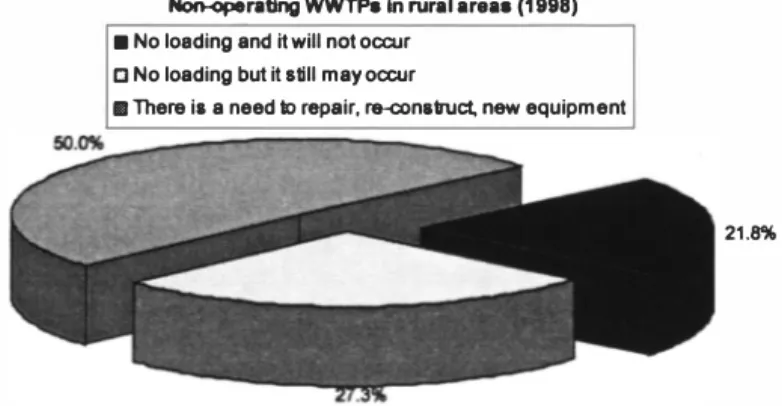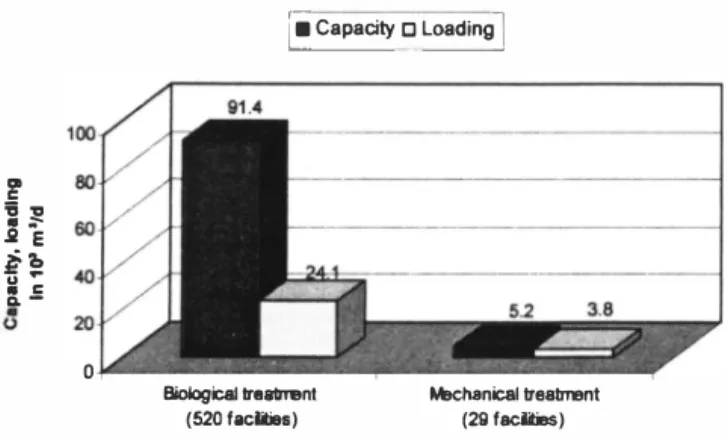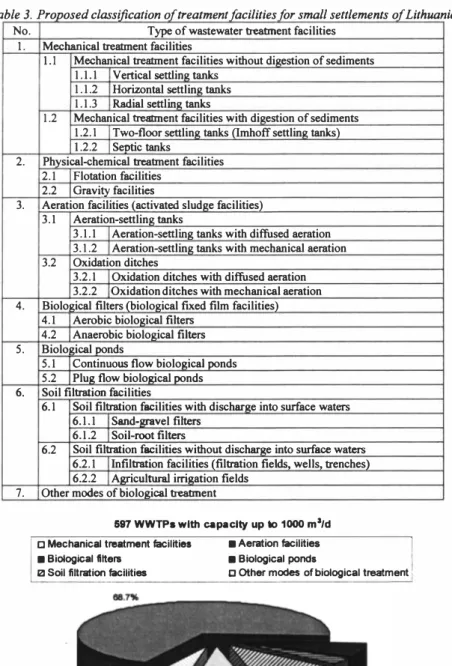29
THE PRESENT SITUATION AND TRENDS
OF WASTEWATER TREATMENT IN SMALL
SETTLEMENTS AND RURAL AREAS OF
LITHUANIA
Regimantas Dauknys
Vilnius Gediminas Technical University, Lithuania
ABSTRACTThis article presents the wastewater treatment in small settlements and rural areas of Lithuania, including descriptions of capacity and loading of wastewater treatment plants (WWTPs), types of treatment facilities, and development trends of biological treatment facilities. In 2000 Lithuania had 597 WWTPs with capacity up to 1000 m 3/d, 95% of them are the biological treatment plants. Today the most of these WWTPs are unloaded due to the tendency to centralise wastewater treatment in rural areas of Lithuania that were in the eight and ninth decades.
In small settlements and rural areas of Lithuania the aeration facilities are predominant. In the eight and ninth decades practically only the activated sludge systems were built. The situation began to change in the last decade of the last century: the biological filters and soil filtration facilities with discharge into surface waters were applied more frequently, so the building of aeration facilities started to decrease.
KEYWORDS
Wastewater treatment, small settlements, rural areas, wastewater treatment plants, biological treatment.
INTRODUCTION
The Republic of Lithuania is a small country with an area of about 65000 km2 and a population of 3. 7 million. Less than halfof the population lives in small settlements and rural areas.
Wastewater collection and treatment on a great part predetermines the state of surface and underground water resources in the general structure of region water management. It has also an influence on matters related to the water quality: human health, recreation conditions, peculiarity oflandscape, streams of tourism, biodiversity, etc.
In the eight and ninth decades it was the tendency to centralise wastewater treatment in the rural areas of Lithuania, i. e. to connect living, public, industrial and agricultural objects into the common sewerage system and to treat wastewater in the municipal wastewater treatment plants (WWTPs). Therefore, in rural areas the most part of WWTPs was built with an excess capacity (for perspective).
Regimantas Dauknys, Lithuania 243
KALMAR ECO-TECH'0I
Leachate and Wastewater Treatment with High-Tech and Natural systems KALMAR, SWEDEN, November 26-28, 2001
Due to the lack of pipes, building materials and other possibilities a great part of the objects was not connected into the sewerage and WWTPs became unloaded or they were not exploited at all.
The Lithuanian experience showed that the centralised (municipal) sewerage and wastewater treatment systems in rural areas have the following disadvantages:
• the quantity of sewage is small but the distances are large. So, the length of pipeline and also construction and maintenance costs for one inhabitant are relatively high;
• the sewerage often plugs due to the great fluctuations of flow rate and the decrease of velocity in the night;
• in most cases the pump stations are required;
• it is difficult to maintenance the complex wastewater treatment facilities due to the lack of skilled personal;
• when wastewater treatment facilities are maintained improperly and optimal loading for these facilities is not created, not only the cost for electricity rises but also the required degree of treatment is not achieved.
The aim of this article is to overview the state of WWTPs in small settlements and rural areas of Lithuania and to reveal the development trends of wastewater treatment.
DEVELOPMENT OF WASTEWATER TREATMENT IN SMALL SETTLEMENTS AND RURAL AREAS
State of wastewater treatment plants during 1995-1998
In the beginning of 1998 Lithuanian cities and settlements had 787 WWTPs with discharge into surface waters and filtration fields. 657 (or 83.5%) of these wastewater treatment plants were located in rural areas. The non-operating treatment facilities in such areas comprised 16.7%, and then this percent was almost 2 times higher in 1995 (31%) (1). According to the data of 1998 a half of the treatment facilities did not operate due to the lack of loading, the other part of facilities did not operate due to required repair, re-construction or absence of required equipment (Figure 1 ).
Non-<,peratlng WWTPs In rural areas (1998)
■
No loading and it will not occur c No loading but it still mayoocur■
There is a need to repair, 11HX1nalnlct, n- equipment21.8%
Figure 1. Distribution of non-operating WWI'Ps in rural areas of Lithuania according to the
74
Table 1. Information on changes managing the wastewater treatment plants in rural areas of Lithuania durinf( 1995-1998 (1)
Re- Under re- Projects (prepared or Year Written off Temporarily closed constructed New construction under preparation)
1995 22 19 8
-
-
-1996 44 24 30 24
-
-1997 8 26 7 12
-
-1998 3 9 29 10 12 40
1995--1998 77 78 46 12 40
74 WWTPs were reconstructed, 46 WWTPs were built and 77 non-operating WWTPs were written off in the period of 1995-1998 (Table I), This explains the increase of operating WWTPs in rural areas of Lithuania,
Capacity and loading of WWTPs
The information on discharge of wastewater and operation of wastewater treatment plants is collected in the Joint Research Centre of the Ministry of Environment of Lithuania, Therefore, for this study data were taken from the Joint Research Centre (2),
In order to characterise the wastewater treatment facilities in small settlements and rural areas of Lithuania in 2000, the WWTPs with capacity up to 1000 m3/d were analysed,
When the treatment facilities of more than 1000 m3/d capacity were rejected, it is obtained that in 2000 Lithuania had 597 WWTPs with capacity up to 1000 m3/d, 549 of them had discharge into surface waters and 48 of them were filtration fields including agricultural irrigation fields,
These 597 WWTPs were grouped according to the capacity, Five groups were chosen, The obtained results are given in Table 2,
Table 2. The distribution of wastewater treatment plants accordinf( to the capacity
Capacity of WWTPs, Number ofWWTPs, Population equivalent % of total number of
m3/d unit (PE) WWTPs up to SO 155 up to 200 26 51-100 156 200-400 26 101-250 167 400-1000 28 251-500 77 1000-2000 13 501-1000 42 2000-4000 7
The WWTPs with capacity up to 250 ms3/d are predominated. Such treatment facilities
comprise 80% of total number of analysed WWTPs. The facilities with capacities of 251-500 m3/d comprise 13% and the facilities with capacities of 501-1000 m3/d comprise 7% of
total number of the WWTPs,
Total capacity and loading of treatment facilities with discharge into surface waters were compared, The results are summarised in Figure 2,
The total capacity of WWTPs that have the biological treatment step very differed from the total loading, In 2000 the employment of these facilities was 26%. The total employment was 29%. Such situation formed due to the tendency to centralise wastewater treatment in rural areas of Lithuania that were in the eight and ninth decades.
KALMAR ECO-TECH'0I
Leachate and Wastewater Treatment with High-Tech and Natural systems KALMAR, SWEDEN, November 26-28, 2001
WWTPs with discharge into surface waters (2000) � Capacity
□
LoadingJ
g'j
l!Re
j'o u ■... -
� C Mechanical treatment (29 faciiies)Figure 2. Distribution of total capacities and loading of WWI'Ps with capacity
up to 1000 m3/d (data of 2000)
Today the most of WWTPs with capacity up to 1000 ms3/d are unloaded, so their effective operation usually cannot be ensured. According to the obtained results the biological treatment facilities that are applied in small settlements and rural areas of Lithuania should be orientated to the capacity up to 150 ms3/d.
Types of WWTPs
Trying to determine the distribution of types of wastewater treatment facilities and their distribution in respect of the year of construction, the WWTPs with capacity up to I 000 ms3 /d (597 WWTPs) were grouped according to the proposed classification of treatment facilities for small settlements of Lithuania (Table 3). This classification is based on the following considerations:
• the wastewater treatment facilities are grouped according to the main step of wastewater treatment;
• the group of biological treatment facilities is subdivided into four subgroups according to the intensity of treatment process: a) activated sludge facilities, b) biological fixed film facilities, c) biological ponds, d) soil filtration facilities;
• the biological filters are grouped according to the conditions that are created for micro organisms, i. e. aerobic biofilters and anaerobic biofilters;
• taking into account that filtration is performed through the man-formed or natural soil, it is proposed the filtration facilities to call as soil filtration facilities and to subdivide them into two subgroups: a) soil filtration facilities with discharge into surface waters, and b) soil filtration facilities without discharge into surface waters;
• non-pure types or hybrid facilities are classified according to the predominant mode of
treatment or they are attached to the group "other modes of biological treatment.
The distribution of WWTPs according to the type is shown in Figure 3. In Lithuania the biological treatment is the most commonly used wastewater treatment method. As the main treatment step it is applied in the 95% of the WWTPs with capacity up to l 000 m3 /d. The WWTPs with mechanical treatment comprise only 5%. The physical-chemical treatment was not applied in small settlements and rural areas of Lithuania in 2000.
0
Biological treatm,nt (520faclities)
6,
Ta b/e 3. Proposed classification of treatment facilities for small settlements of Lithuan ia No. Type of wastewater treatment facilities
], Mechanical treatment facilities
LI Mechanical treatment facilities without diszestion of sediments 1,1,1 Vertical settlinsz tanks
1,1,2 Horizontal settlinsz tanks
1,1,3 Radial settlinsz tanks
1,2 Mechanical treatment facilities with diszestion of sediments
L2.l Two-floor settlinsz tanks CTmhoff settlinsz tanks) l.2,2 Seotic tanks
2, Physical-chemical treatment facilities 2,1 Flotation facilities
2,2 Gravity facilities
3, Aeration facilities (activated sludge facilities)
3,1 Aeration-settling tanks
3,1,1 Aeration-settling tanks with diffused aeration
3,l.2 Aeration-settling tanks with mechanical aeration
3,2 Oxidation ditches
3.2.1 Oxidation ditches with diffused aeration
3,2,2 Oxidation ditches with mechanical aeration
4, Biological filters (biological fixed film facilities) 4,1 Aerobic biological filters
4,2 Anaerobic biological filters 5, Biological ponds
5,1 Continuous flow biological ponds 5,2 Plug flow biological ponds
Soil filtration facilities
6,1 Soil filtration facilities with discharge into surface waters 6,1,1 Sand-lll'llvel filters
6,1,2 Soil-root filters
6,2 Soil filtration facilities without discharge into surface waters 6.2.1 Infiltration facilities ( filtration fields, wells, trenches)
6,2,2 Agricultural irrigation fields
7, Other modes of biological treatment
587 WWTPs with capacity up to 1000 m1/d
□
Mechanical treatment facilities■
Aeration facilitiesJ
■
Biological ftltera■
Biological ponds121 Soil filtration facilities c Other mcxles of biological treatment
!
Figure 3. The distribution ofWWTPs according to the type in 2000
20
KALMAR ECO-TECH'0 I
Leachate and Wastewater Treatment with High-Tech and Natural systems KALMAR, SWEDEN, November 26-28, 2001
Aeration facilities Biological ftltera
20 20 -,---· 120 18 +---· 100 100 18 ,._ ____________ , � 14 +------·
�
80 � 12 ,._ _____________ , 9 80 li 10 } 8+-----.!
40j
1
6 4 +--"----0_l.!
2 0 1981- 1886,, 1871- 1� 1811- 1916- 1981- 1895- 185� 1981- 19el5-- 1871- 197tr 1981- 198&- 1991- 1� 11185 1970 1175 1180 11185 1890 1895 2000 1960 1985 1870 1975 1980 1H5 1HO 1985 2000 Year Year Biological ponds 20 ..---. 18 .,__ ____________ -If
4 +---�----,�1
I
i
6 2 0 1181- 1- 1171- 1176- 11181- 11116- 111111- 111116-11185 1870 1975 1880 11186 1890 111115 2000 YearSoll filtration facllltln without discharge Soll filtration facilities with discharge
Into surface wat.ra Into surface wat.ra
20 18
i
18i
16 16 14 14 12 12 't5 10 't5 10 8 } 8}
i
6 6i
4 4 2 2 0 0 11180- 1-. 1171- 1W.- 1911- 1- 1181- 19118- 1880- 1- 1971- 197&- 18111- 11116- 111111· 111116-1986 1870 1875 1NO 1Na 1890 1895 2000 1Na 1870 1175 1880 18115 111110 1- 2000Year Year
Reviewing the biological treatment in small settlements and rural areas of Lithuania it may be stated that the aeration facilities are predominant (68.7% of analysed WWTPs). The soil filtration facilities take the second place according to the abundance. But they comprise 10.6% of total number of analysed WWTPs. The biofilters take the third place; their part is 7% only. In Lithuania the biological ponds are usually used as final treatment step. For the main step the biological ponds are used seldom, so their number is the smallest and comprises 3% of total number of the WWTPs.
Biological treatment
The development of different biological treatment facilities up to 1000 ms3/d is illustrated in Figure 4. In Lithuania all modes of biological treatment were valued more or less evenly up to the end of 1970. But in the eight and ninth decades practically only the activated sludge systems were built. The attention was so concentrated on the development of these technologies that the most specialists forgot the good points of other biological treatment methods. This fact stipulated the decrease of WWTPs in which the biological filters were used.
In the period of 1976-1990 several soil filtration facilities without discharge into surface waters were built. The most probably these facilities were built due to the absence of surface waters close to the objects or due to the favourable filtration conditions and possibility to use the required areas ofland (for such facilities usually considerable areas of land are required). In the last decade of the last century the building of aeration facilities began slightly decrease. Such trend formed due to more frequent application of biological filters and soil filtration facilities with discharge into surface waters (Figure 4). The experience of foreign countries was also influenced the reviving of building of these treatment facilities. Lately the construction of aeration facilities decreased but the activated sludge systems still remain the main systems that are used for wastewater treatment in small settlements and rural areas.
The more detailed analysis of the construction of biofilters and soil filtration facilities with discharge were performed.
Soll filtration facilities with dlacharge Into aurface waters
Biological filters
f ■ aerobic c anaerobic : �� sand-grawl filters
c
soil-root filtersI
10 -- 10 9 9
t.
i
e
.!
8 7 8 5"'
i
0j
8 7 6 5"'
E 3 Ei
2 1 0■ ■ ■
fh
2 1 0■
■ ■
■
■
1- 1981- 1- 1171• 197&- 1981- 1- 11191- 1- 1980- 1871· 187&- 198 188&- 1981·
1-1980 11185 1870 1875 11110 11185 1890 1"6 :IOOO 1N5 1870 1875 1980 1985 11NIO 1"6 2000
Year Year
Figure 5. Building chronology of Figure 6. Building chronology of soil biological filters according to their type filtration facilities with discharge into
surface waters according to their type
KALMAR ECO-TECH 'O I
Leachate and Wastewater Treatment with High-Tech and Natural systems KALMAR, SWEDEN, November 26-28, 2001
Until the end of eight-decade only the aerobic biofilters were built in small settlements and rural areas of Lithuania (Figure 5). In the next decade the biofilters of such type were refused. In 1986-1995 the construction of anaerobic biofilters ( submerged) was started. During this period 10 anaerobic biofilters and only one aerobic biofilter were built. It may be stated that the revival of aerobic biofilters started from 1996. During the five-year period 10 aerobic and 10 anaerobic biofilters were built. So, in the future the number of biofilters should increase and comprise more than 7% of total number of the WWTPs (Figure 3).
Two types of soil filtration facilities with discharge into surface waters are excluded. This is sand-gravel filters and soil-root filters. The latter filters were started to exploit only from 1996 (Figure 6). The first soil-root filters were constructed based on the experience of Scandinavian countries. A part of sand-gravel filters was built earlier, but more widely they are also started to exploit from 1996. So, the number of soil filtration facilities with discharge into surface waters has the trend to increase.
A lot of biological treatment technologies come from foreign countries, some technologies are also proposed by Lithuanian specialists. It may be various solutions of biological wastewater treatment that give the similar result. But their implementation cost may differ several times. The increasing number of biofilters and soil filtration facilities with discharge shows that the systems of biological fixed film and soil filtration seem to be more expedient for the WWTPs with low capacity than the activated sludge systems. However, before the biological treatment technology will be selected the different possibilities should be evaluated taking into account the peculiarity of territory, development of water supply and sewerage systems, capital maintenance costs, maintenance possibilities, environmental requirements.
CONCLUSIONS
1. In small settlements and rural areas of Lithuania the biological treatment is the most commonly used wastewater treatment method. As the main treatment step it was applied in
the 95% of the WWTPs with capacity up to 1000 m3/d in 2000. In 68.7% of these WWTPs
the activated sludge facilities are applied.
2. In 2000 the total capacity of WWTPs that have the biological treatment step very differed from the total loading. The employment of these facilities was 26%. Therefore the biological treatment facilities that are applied in small settlements and rural areas of Lithuania should be orientated to the capacity up to 150 m3/d.
3. In small settlements and rural areas of Lithuania the small (decentralised), cheap and easily maintained WWTPs should be applied more widely. In this respect the systems of biological fixed film and soil filtration has more advantages than the activated sludge systems. That shows the increased building of biofilters and soil filtration facilities with discharge.
4. The suitability of the biological treatment technologies should be discussed complexly taking into account the following aspects: peculiarity of territory (territorial planning), development of water supply and sewerage systems, capital and maintenance costs, maintenance possibilities, environmental requirements.
ACKNOWLEDGEMENTS
I would like to thank Dr. Patricija Didziapetriene for the valuable advises and helping to classify the types of wastewater treatment facilities for small settlements of Lithuania.
REFERENCES
1. Review Information on the State of Wastewater Treatment Plants in Lithuania (1998). Ministry of Environment, Water Department, Vilnius.
2. Summaries of statistical system "Water" (2000). Ministry of Environment of Lithuania, Joint Research Centre, Vilnius.





